Assessing Massachusetts’ ConnectedSolutions Distributed Battery Program – what works, what could improve
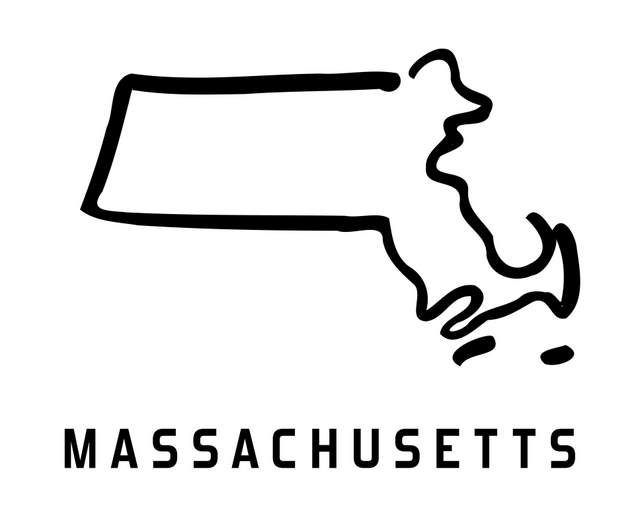
In January 2019, Massachusetts became the first state in the nation to fully incorporate behind-the-meter battery storage into its three-year energy efficiency plan. This was a momentous step for state policymakers. The ConnectedSolutions battery program provided both a new way to fund distributed energy storage, and a new contractual mechanism to aggregate the batteries for utility dispatch during peak demand hours, a peak load-reducing service that produces cost savings for all ratepayers. The ConnectedSolutions model was soon adopted by Rhode Island and Connecticut, and similar programs are operating or being developed in the other New England states. Several states outside of New England are also considering the model.
Clean Energy Group (CEG), a national nonprofit organization working to advance innovative clean energy policies and programs, advocated for the battery program in Massachusetts and supported its adoption with independent economic analysis. Now, nearly three years later, CEG has published a new report looking at how the program has been implemented in its first three-year cycle, and how it could be improved for the Commonwealth’s 2022-2024 energy efficiency plan.
Program success
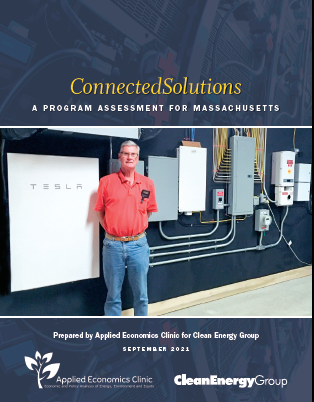
By most measures, the ConnectedSolutions program been very successful in Massachusetts. In the first two years (2021 program data is not in yet), enrollment nearly doubled, from 769 to 1,105 commercial/industrial (C&I) customers and from 17,000 to 33,000 residential customers. The cost-to-benefit ratio also improved: for every program dollar spent in 2020, planned benefits totaled $4.18 for C&I customers and $2.14 for residential customers. This is a significant improvement over the expected $3.80 in C&I benefits and $1.78 in residential benefits.
In terms of peak shifting – the main benefit of the program – Massachusetts Active Demand Reduction programs (of which the ConnectedSolutions battery program is a part) reduced the statewide peak summer load by 0.9 percent in 2020. That may not seem like much, but it has an outsized impact on ratepayer costs. Electricity generation that serves peak load is the most expensive generation in the state’s portfolio; in fact, a 2018 study found that the top 10 percent peak load hours account for 40 percent of the state’s total cost for electricity. Not only is it expensive – serving peak demand is also highly polluting, which is why Massachusetts has also adopted the nation’s first Clean Peak Electricity Standard. So any program that cost-effectively reduces peak load – and can be scaled up quickly as a distributed battery program can – is good news for the Commonwealth.
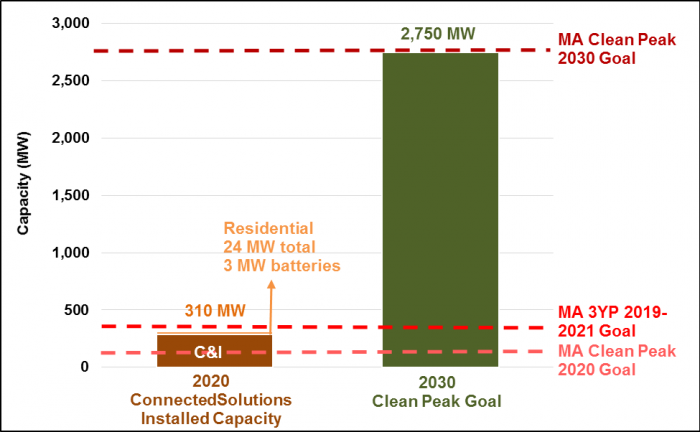
Room to improve
Of course, any program can be improved, and there is much room for improvement in the Massachusetts ConnectedSolutions program.
For one thing, despite the Commonwealth’s longstanding commitment to make clean energy programs accessible to low-income and historically underserved communities, the ConnectedSolutions battery program was implemented with no provisions to support participation by low-income utility customers. This is a serious omission, since underserved communities are most in need of the benefits of battery storage – such as clean resilient power and energy cost savings – and are also most impacted by dirty fossil-fuel peaker plants, which are frequently sited in low-income urban neighborhoods. The ability of aggregated, distributed energy storage to provide peaking services is an essential element of the economic case for the ConnectedSolutions battery program, and batteries are expected to help replace existing fossil fuel peakers as they are retired.
Another shortcoming is the small overall program budget, which represents a tiny fraction of the Commonwealth’s spending on energy efficiency (Massachusetts energy efficiency budgets exceed $620 million annually). If the Commonwealth is to meet its clean peak and energy storage procurement goals, it will need to substantially expand the ConnectedSolutions battery program. This means offering higher performance payment rates to enrollees, commensurate with what other, more traditional providers of peak capacity are paid, along with other program improvements like longer customer contracts, which would help reduce risk and increase financeability for battery projects.
Finally, the program administrators for ConnectedSolutions need to be more transparent in reporting program data, to make this publicly funded effort resemble an open book more than a black box.
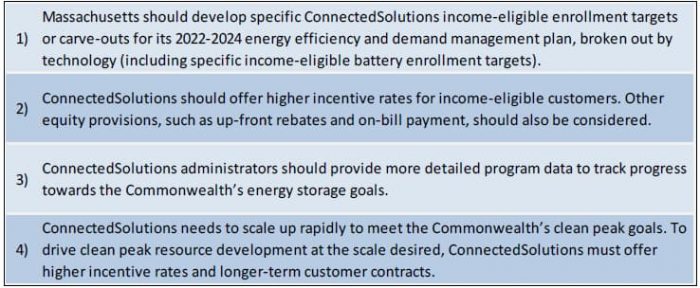
Final thoughts
So, the takeaway for Massachusetts is that ConnectedSolutions is off to a good start with the nation’s first customer battery program housed within a state energy efficiency plan. There are a few areas that need improvement and the 2022-2024 plan should address them, but the Commonwealth has provided a viable and replicable new economic model for distributed battery funding. Like net metering for solar, ConnectedSolutions could transform battery markets nationwide.
Perhaps the best news is how quickly the ConnectedSolutions model is being picked up and developed by other states.
Connecticut, in particular, recently announced a nine-year, 580 MW Statewide Electric Storage Program that was modeled on ConnectedSolutions, but includes a number of innovative new provisions to improve low-income access, such as upfront rebates (in addition to performance payments), significant income-eligible incentive adders, and on-bill payment options. The Connecticut program shows how the basic funding model developed in Massachusetts can be adapted by other states to support not only peak demand reduction, but also clean energy equity goals – increasingly a priority both at the state level and nationally.
CEG is continuing its work with state policymakers and other stakeholders, both to expand and improve the ConnectedSolutions model within New England, and to support adoption of the model in states outside New England.
Todd Olinsky-Paul is Senior Project Director for Clean Energy Group and the Clean Energy States Alliance, two nonprofits located in Montpelier, VT. For more information on the ConnectedSolutions program and other energy storage information, visit CEG’s website.




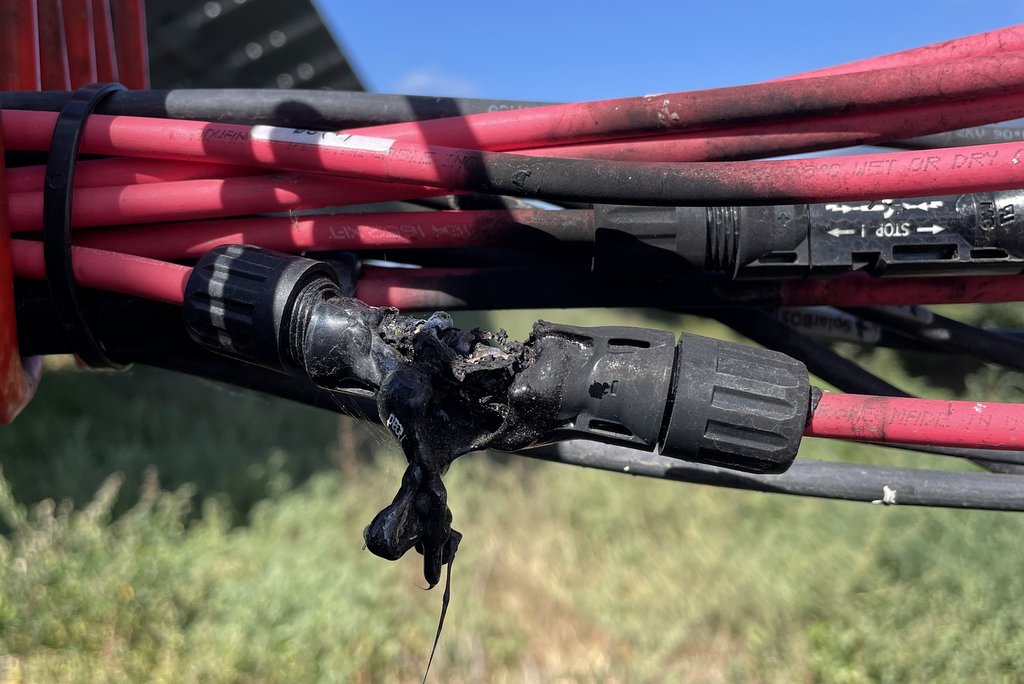
Comments are closed here.